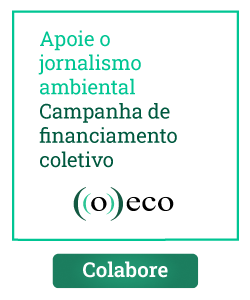Em português
Leia matéria sobre Porto Brasil de Cristiane Prizibiscki – Porto da Discórdia
It is a classic tale of David and Goliath. A handful of Tupi-Guarani Indians, backed up by ornithologists concerned about some rare parrots, taking on Brazil’s richest man and his plan to construct the biggest port in Latin America.
 That, in caricature, is the battle currently under way over proposals by the mining and logistics entrepreneur Eike Batista and his LLX company to build a R$6bn (US$3.6bn) mega-port, known as Porto Brasil, on the Atlantic coast South of São Paulo.
That, in caricature, is the battle currently under way over proposals by the mining and logistics entrepreneur Eike Batista and his LLX company to build a R$6bn (US$3.6bn) mega-port, known as Porto Brasil, on the Atlantic coast South of São Paulo.
The battle also represents an important test of the seriousness with which the Brazilian decision-making process, in all its complexity at local, state and federal levels, values what remains of the unique coastal ecosystems that have felt the onslaught of 500 years of development since the arrival of the Portuguese in Brazil.
First, a bit of background. The proposal is for a massive container port to take pressure off the one at Santos, currently Latin America’s busiest. The huge queues of trucks which build up at Santos and at the next major port to the South at Paranaguá, are seen as damaging bottlenecks to Brazil’s trading infrastructure, which will become increasingly serious as the country’s economy grows.
Porto Brasil would include an offshore island with 11 berths capable of loading deep-draught vessels, the largest of which are currently unable to access Brazilian ports. Onshore, the main loading area of six square kilometers would handle up to four million standard freight containers (TEUs) a year. Behind the port itself, a 13 sq km industrial zone would house auto and electronics factories, food processing units and other “high value-added” industries, according to the publicity of the port’s proponents.
 Looking at the location of the proposed port on Google Earth (see illustrations) helps to illustrate both the attractions of the Porto Brasil project and the reason it is causing such controversy. It would fill in the only remaining patch of green along the continuous strip of beachfront urban sprawl, stretching for some 100km from Santos to the mountains of the Jureia-Itatins protected area, one of the most important remaining sanctuaries of the Atlantic Forest.
Looking at the location of the proposed port on Google Earth (see illustrations) helps to illustrate both the attractions of the Porto Brasil project and the reason it is causing such controversy. It would fill in the only remaining patch of green along the continuous strip of beachfront urban sprawl, stretching for some 100km from Santos to the mountains of the Jureia-Itatins protected area, one of the most important remaining sanctuaries of the Atlantic Forest.
Apart from its proximity to the economic powerhouse of South-East Brazil and its agricultural hinterland, the port and its promised jobs (30,000 during construction, 5,000 permanent) holds obvious appeal to a region which depends for its income on the seasonal disgorging of the mega-city of São Paulo, 700m up on the plateau, to its nearest coastline during the summer holiday periods.
Biodiversity Hotspot
The municipality of Peruibe, within whose boundaries the port is planned, has grown rapidly in recent years largely through development of holiday homes and gated communities which remain empty for much of the year.
 The mayor of Peruibe’s special adviser, Sílvio Siqueira Junior, explains, “We have a serious problem in Peruibe today, which is that it survives on the season, the veraneio (summer vacations). In practice, we’ve got the period from December to February, when the place is crowded with tourists – and for the rest of the year, traders have to survive on the business they do during that season.
The mayor of Peruibe’s special adviser, Sílvio Siqueira Junior, explains, “We have a serious problem in Peruibe today, which is that it survives on the season, the veraneio (summer vacations). In practice, we’ve got the period from December to February, when the place is crowded with tourists – and for the rest of the year, traders have to survive on the business they do during that season.
“We believe that an enterprise on this scale will make a whole series of other businesses possible, which at the moment are unviable in Peruibe and the surrounding region.”
Siqueira admits, however, that “there are more questions than answers” surrounding the detailed proposals for the port, not least of which is the environmental impact it would have.
That little patch of green, as it appears from a satellite photo, is in fact highly significant in the mosaic of varied and contrasting habitats which are collectively referred to as the Atlantic Forest (or Mata Atlântica in Portuguese), the ecosystem that once stretched in a continuous swathe along the entire Eastern coast of Brazil, and inland as far as Paraguay and Northern Argentina – but which has lost at least 93% of its original extent.
 One of the reasons that the region holds an exceptional variety of plant and animal species (it is classed as a Biodiversity Hotspot by Conservation International) is that the landscape rises rapidly from sea level to the mountain range known as the Serra do Mar, giving rise to an inter-connected series of habitat-types, each with its own unique set of species.
One of the reasons that the region holds an exceptional variety of plant and animal species (it is classed as a Biodiversity Hotspot by Conservation International) is that the landscape rises rapidly from sea level to the mountain range known as the Serra do Mar, giving rise to an inter-connected series of habitat-types, each with its own unique set of species.
Among the most threatened of these habitats is the restinga, the term used for the forest growing in the white sands of the coastal plain, often in a very narrow strip between the tidal zone and higher ground. Plants in these areas have evolved specific survival strategies to deal with low levels of nutrients and soil moisture, and they have their own characteristic flora such as ground-growing bromeliads and stunted trees.
By their nature, restinga forests tend to be in the way of coastal developments seeking flat land near a beach, and the zone proposed for Porto Brasil is one of the very few places where there is a continuous undeveloped area linking the mountains to the ocean.
Parrots
 Its importance has been emphasized recently by the discovery of a colony of an endangered parrot species, the Red-tailed Parrot (Amazonas brasiliensis), whose entire global range consists of a small strip of coastline barely 200km in length, and which has suffered badly from habitat loss and capture for the pet trade.
Its importance has been emphasized recently by the discovery of a colony of an endangered parrot species, the Red-tailed Parrot (Amazonas brasiliensis), whose entire global range consists of a small strip of coastline barely 200km in length, and which has suffered badly from habitat loss and capture for the pet trade.
The colony of around 150 individual parrots is thought to be the northernmost outpost of the species, and at least one of its “dormitories” – the collective roosts where the birds gather at dusk for mutual protection – is in the very area that would form part of the industrial zone in the current plans for the port.
The presence of the parrots, together with several other species unique to the coastal lowlands of the Atlantic Forest, has led the respected international NGO Birdlife International to include this location in its global network of Important Bird Areas (IBAs), places deemed to be priorities for conservation.
The ornithologist and bird guide Bruno Lima, who regularly brings foreign birdwatchers to this site, comments, “If we lose it, we lose it forever. It’s the last great important area on the São Paulo coast. People love this area, they come here to see the birds and nature.
“We really need this area, it’s very important. More than we know.”
Listen to the sound of red-tailed parrots flying.
The company wishing to develop the port, LLX, insists that it places a high priority on environmental responsibility, and that before the project goes ahead there will be a full assessment of the flora and fauna, impacts on the coastal ecosystem and other requirements of the public authorities that would license the project.
The indigenous obstacle
 Those studies have yet to be carried out, but in the meantime a more immediate obstacle needs to be overcome by the port developers. Around 50 families of Tupi-Guarani Indians currently occupy parts of the area proposed for the port, among the very few indigenous people still claiming rights to Brazil’s coastline from which they were displaced by the European settlers from the 16th century.
Those studies have yet to be carried out, but in the meantime a more immediate obstacle needs to be overcome by the port developers. Around 50 families of Tupi-Guarani Indians currently occupy parts of the area proposed for the port, among the very few indigenous people still claiming rights to Brazil’s coastline from which they were displaced by the European settlers from the 16th century.
The company claims these Indians are effectively squatters who only arrived on the land eight years ago, and they have offered alternative homes to the families on a nearby estate – together with other incentives such as a 4 x 4 Mitsubishi vehicle for the use of the community. The issue has split the families, with the majority accepting these terms and a smaller group determined to stay.
The local office of the federal indigenous affairs agency Funai has compared these tactics with those of the Portuguese 500 years ago, offering trinkets like mirrors and hairbrushes to the original inhabitants of Brazil in return for land. The agency is attempting to get the land officially demarcated as Indian territory – if this is approved by the government in Brasilia, it will be virtually impossible for the port to proceed. A public meeting on the proposal was suspended in March when federal prosecutors gained a court injunction claiming it was premature to proceed with formal consultations on the port while the question of the Indians was unresolved.
So it is still not clear whether the environmental importance of the site will be fully put to the test. Another obstacle has arisen with proposals from the São Paulo state government to create a new marine environmental protection zone along this coast – while mainly directed at control of commercial fishing, it could complicate the licensing of the port.
If the port developers get past these other hurdles, the municipality of Peruibe would still need to change its own local zoning plan, which currently prohibits development on the restinga forest. That in turn will give rise to a fierce local debate about what type of development is appropriate for the region.
According to Plínio Melo from the NGO Mongue, which campaigns for conservation of coastal habitats and traditional communities in the area, Peruibe should concentrate on its unique assets.
“Metal-works, cement plants, the auto industry, you can find those anywhere in the world,” says Melo. “But only we have this preserved Atlantic Forest, no one else has got it any more. So any type of investment should be based on that regional vocation – in other words, environmental and ecological tourism.”
* Tim Hirsch is former BBC environmental correspondent and lives in Brazil. Read also his blog – The life at Atlantic Forest.
Leia também

Desmatamento no Cerrado cai no 1º semestre, mas ainda não é possível afirmar tendência
Queda foi de 29% em comparação com mesmo período do ano passado. Somente resultados de junho a outubro, no entanto, indicarão redução de fato, diz IPAM →

Unesco reconhece Parna dos Lençóis Maranhenses como Patrimônio da Humanidade
Beleza cênica e fato de os Lençóis Maranhenses serem um fenômeno natural único no mundo levaram organização a conceder o título →

Dez onças são monitoradas na Serra do Mar paranaense
Nove adultos e um filhote estão sendo acompanhados pelo Programa Grandes Mamíferos da Serra do Mar. Primeiro registro ocorreu em 2018 →








